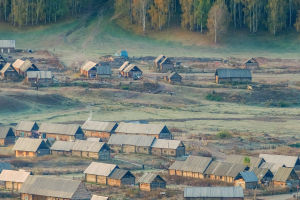On the hillside, you can observe numerous rice paddies arranged in a stepped pattern known as "hutada" or terraced rice paddies in Japanese.
These rice paddies serve as the primary cultivation areas for rice, which is a staple food in Japan. Traditionally, rice fields are cultivated in open lowland areas. However, due to the mountainous terrain covering approximately 70 percent of Japan's land, lowlands are scarce in the country.
This unique environmental characteristic has given rise to the development of hutada or terraced rice fields. These fields are reclaimed on hillsides or in valleys and resemble ladders in appearance. Although each individual rice paddy is small, this style of cultivation allows for efficient utilization of limited land, leading to the widespread adoption of this practice throughout Japan.
Approximately 8% of paddy fields in Japan are cultivated in the form of hutada or terraced rice fields, and when including small paddy fields, the number of terraced rice fields can reach the thousands. Consequently, these rice terraces are also referred to as "Thousand Paddy Fields."
The irregular arrangement of the rice fields creates a distinctive geometric pattern, resulting in a visually striking landscape. During spring, when the seeds are sown, the sun's rays reflect off the water surface of the paddy fields.
In autumn, during the harvest season, the rice ears turn a golden hue, further enhancing the scenic beauty. The appearance of terraced rice fields undergoes captivating transformations with the changing seasons, resembling abstract paintings. The allure of these rice paddies extends beyond their agricultural purpose, making them popular tourist attractions that offer relaxation and tranquility.
Terraced rice fields not only contribute to the aesthetic beauty of the landscape but also serve a crucial function in food production. However, their significance extends far beyond that.
One of their remarkable capabilities is water retention. Japan receives ample rainfall, but due to its small size and mountainous topography, if the landscape were left untouched, rainwater would flow directly into the sea, preventing people from harnessing and storing the water necessary for their livelihoods.
The unique shape of terraced rice fields prevents rainwater from rapidly draining into the sea. In a way, these fields effectively harness the power of nature, acting as natural dams and ensuring a sufficient water supply for the land.
Terraced rice fields are reclaimed while preserving the natural environment and their original appearance, providing habitats for numerous animals, insects, and plants. As urbanization continues to encroach upon natural habitats worldwide, many species face the risk of extinction.
However, areas with terraced fields contribute to the preservation of ecosystems, offering the opportunity to encounter a diverse array of animals and plants that might not typically be found in urban settings.
The tradition of terraced rice paddies in Japan dates back centuries, with theories suggesting their existence as early as 600 to 700 AD. It is astonishing to consider that these terraces have endured for such a long time and continue to play a vital role in safeguarding people's livelihoods even after 1,400 years.
A unique type of Japanese terraced rice paddies is called "Ishigaki shakudani" or terraced rice paddies made of stones. This particular style involves constructing stone steps to form terraces.
The technique of building stone steps draws inspiration from the methods employed in the construction of Japanese castles, where magnificent stone walls support the colossal structures. The shakudani or terraced fields benefit from this stone wall technique, contributing to the creation of beautiful scenery while nurturing and protecting various forms of life.


